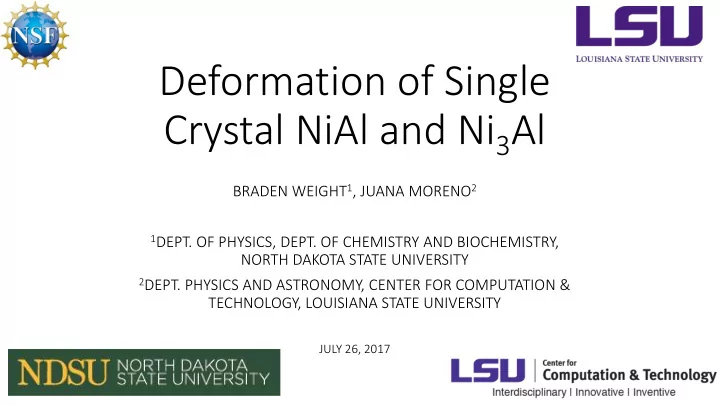

Deformation of Single Crystal NiAl and Ni 3 Al BRADEN WEIGHT 1 , JUANA MORENO 2 1 DEPT. OF PHYSICS, DEPT. OF CHEMISTRY AND BIOCHEMISTRY, NORTH DAKOTA STATE UNIVERSITY 2 DEPT. PHYSICS AND ASTRONOMY, CENTER FOR COMPUTATION & TECHNOLOGY, LOUISIANA STATE UNIVERSITY JULY 26, 2017
SuperAlloys • Properties • High ductility, even at high temperatures • Oxidation Resistant • Low Density • Applications • Advanced aerospace structures and propulsion systems • Electronic metallization for use in semiconductors http://www.tested.com/science/space/454860-nasa-mines-saturn-v-history-future-rocket-engines/ D.B. Miracel (1993)
Mechanical Properties • Defect analysis is essential to the creation of sturdy and long-lasting alloys • Introduce spherical voids at the center of a simulation cell • Measure mechanical properties: • Stress-strain curve/Yield point • Elastic Constants
Methods: Molecular Dynamics • Ni 3 Al – Perfect Lattice LAMMPS was used to integrate Newton’s equation of motion (using Verlet’s method) • NPT Ensemble Conditions • Collected a timeseries of configurations at various values of strain. • Dislocations occur along highest- density planes (90a o ) 3 – 32 nm sides 2,916,000 Atoms Color Coding: Blue/Red – Ni/Al atoms Green – Volumetric Strain depicting slip planes in the fcc lattice
Spherical Voids • We define a periodic box of volume (La o ) 3 , where a o is the lattice spacing of the material and L is an integer. Material a o (Exp.) a o (EAM Results) Error 2.88 Å 2.83 Å NiAl 1.73 % 3.57 Å 3.53 Å Ni 3 Al 1.12 % • We explored the parameter space: • Simulation Cell Size (L) • Void volume fraction L = 100 = 10 % = 10% L = {5, 10, 15, 30, 45, 60, 75, 90, 100, 125} = {0, 0.01, 0.02, 0.04, 0.05, 0.06, 0.08, 0.10} Mishen et Al. (2009)
Perfect Lattice with Varying Cell Sizes Elastic Inelastic/Plastic Deformation Deformation Ni 3 Al NiAl
Ni 3 Al : = 1% Ariza et al. (2013, 2015), Tschopp et al. (2010, 2013)
NiAl : = 1%
Ni 3 Al Yield Stress at the Thermodynamic Limit b Yield = 𝑏 + La o (%) a (GPa) b 0 13.72 -0.0012 1 9.78 43.06 2 9.60 30.83 4 9.07 28.60 6 8.75 24.93 8 8.20 29.09
NiAl Yield Stress at the Thermodynamic Limit Yield = 𝑏 + b La o (%) a b 0 20.12 0.014 1 9.76 12.79 2 9.90 0.111 4 9.34 11.57 6 9.39 0.0085 8 9.15 0.51
Further Work • Collect strain rates of 10 7 to 10 11 (s -1 ) to test for convergence • Collect more extreme temperature variation data • Melting point of the materials 1700 K • Near 0 K (for MD, we choose 1 K as a benchmark) • Further analyze the geometries of the dislocation networks and examine the mechanisms that cause them to interact
References • M.A. Bhatia, M.A. Tschopp, K.N. Solanki, A. Moitra, M.F. Horstenmeyer. Deformation of Nanovoid in a Single Crystal Aluminum. Materials Science and Technology . (2010). • M.A. Bhatia, M.A. Tschopp, K.N. Solanki, A. Moitra. Investigating Damage Evolution at the Nanoscale: Molecular Dynamics Simulations of Nanovoid Growth in Single Crystal Aluminum. Metallurgical and materials transactions A . (2013). • S. Chandra, N.N. Kumar, M.K. Samal, V.M. Chavan, R.J. Patel. Molecular Dynamics Simulations of Crack Growth Behavior in Al in the Presence of Vacancies. Computational Materials Science . (2016). • G.P. Purja Pun, Y. Mishin. Development of an Interatomic Potential for the Ni-Al System. Philosophical Magazine . (2009). • M. Ponga, M. Ortiz, M.P. Ariza. Coupled Thermoelastic Simulation of Nanovoid Cavitation by Dislocation Emission at Finite Temperature. Coupled Problems Conference. (2013). • LAMMPS. http://lammps.sandia.gov/ • Ovito. https://ovito.org/ • C. Luebkeman, D. Peting. Stress-Strain Curves. University of Oregon. Lecture Slides. (2012).
References Cont. • M. Ponga, M. Ortiz, M.P. Ariza. Finite-Temperature non-Equilibrium quasi- Continuum Analysis of Nanovoid Growth in Copper at Low and High Strain Rates. Mechanics of Materials . (2015). • D.B. Miracle. The Physical and Mechanical Properties of NiAl. Acta Metall. Mater. (1993). • Murray S. Daw and M. I. Baskes. Embedded-Atom Method: Derivation and Applications to Impurities, Surfaces, and Other Defects in Metals. Physical Review B . (1984).
Centrosymmetric Parameter • Measures local disorder in a crystal on a per-atom level • For FCC and BCC structures, N is set to 12 and 8, respectively • For perturbations on the order of k b T, CS is near 0.
Dislocation Analysis • In the FCC lattice: • Slip Plane: {111} 𝑏 𝑝 • Burger’s Vector (Direction of Dislocation): B = 2 <110> • In the BCC lattice: (More Complicated) • Slip Plane: {110}, {112}, and {123} 𝑏 𝑝 • Burger’s Vector: B = 2 <111> http://www.eng.fsu.edu/~kalu/ema4225/lec_notes/Web%20Class_13a_final.ppt Ariza et al. (2013, 2015)
Partial Dislocations • Burger’s Vector (length and direction of lattice distortion) will decompose due to energy minimization • b 1 = b 2 + b 3 , where the criterion for decomposition is “Frank’s Energy Criterion”: • | b 1 | 2 > | b 2 | 2 + | b 3 | 2 • This decomposition creates loops around (instead of lines away from) the void due to vector addition • “Perfect” Dislocation: b 1 • “Partial” Dislocation: b 2 + b 3 https://www.tf.uni-kiel.de/matwis/amat/def_en/kap_5/backbone/r5_4_2.html
Recommend
More recommend